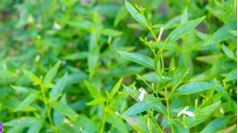




Disclaimer: Copyright infringement not intended.
Context
Andrographis theniensis
Origin and Naming:
Botanical Characteristics:
Distinct Features:
Geographical Distribution:
Taxonomic Significance:
Traditional Uses:
Herbal Remedy Contribution:
|
PRACTICE QUESTION Q. The native range of Andrographis includes tropical Asian countries. In which region are the majority of Andrographis taxa concentrated, especially in India and Sri Lanka? a) Eastern Ghats b) Northern India c) Southern India and Western Ghats d) Himalayan foothills Answer: c) Southern India and Western Ghats Explanation The majority of Andrographis taxa are concentrated in Southern India and the Western Ghats. This region is known for its rich biodiversity, and Andrographis, a tropical Asian genus, finds favorable conditions in the diverse ecosystems of Southern India and the Western Ghats. The plant is well adapted to the climatic and environmental conditions prevalent in this area, contributing to its prevalence in the mentioned region. |









© 2025 iasgyan. All right reserved